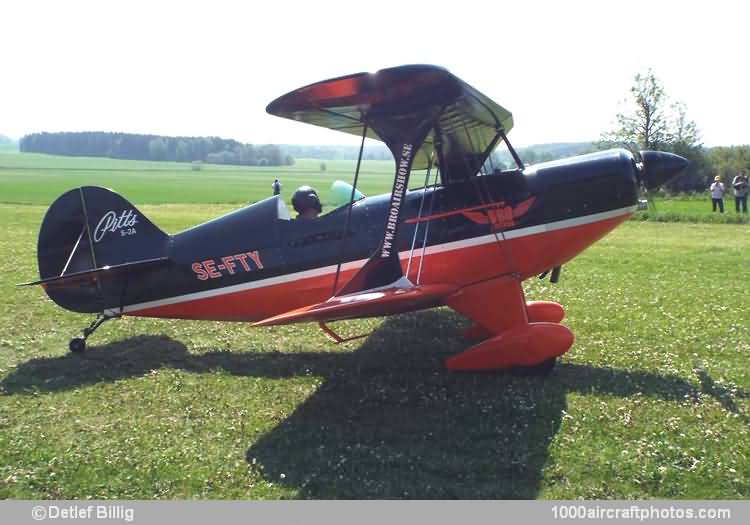09/30/2014. Remarks by Johan Visschedijk: "The Pitts Special aerobatic biplane was designed and built by cropduster Curtis Pitts in 1944. The first aircraft, with a 55-hp Lycoming engine was underpowered, but a second 85 hp version was built for American woman aerobatic champion Betty Skelton. Named Little Stinker this Pitts Special won the US Women's title four years in a row, from 1948 to 1951. A third aircraft named Black Beauty and powered with an 125 hp Lycoming was built for Miss Caro Bayley. The design remained virtually unknown until the revival of competition aerobatics in the USA in the mid-1960s, when the basic airframe was modified to take engines up to 180 hp. US National champion Bob Herendeen burst on the international scene at Magdeburg in 1968, as third in the World Championships.
The key to the Pitts' success lay in its tiny airframe, spanning just 17ft 4 in (5.28 m) and weighing only 720 lb (326 kg) empty, coupled to a powerful engine giving a high power/weight ratio. The airframe, which combines a welded steel tube fuselage and wooden wings, is stressed to +9 and -4,5 g and can be rolled at rates exceeding 360° per second.
The Pitts has been marketed as a homebuilt for engines in the 125 to 180 hp range, and is known as the S-1D in this form. Plans for the similar S-1E became also available, this had wings of symmetrical airfoil section. Factory-built aircraft with special competition wing airfoils were designated S-1S, and it was this model which was the favorite mount of acrobatic pilots. The S-1T was an advanced model with the wing moved 4.5 in (11.50 cm) forward to compensate for the installation of a 200 hp engine.
In 1967 Curtis Pitts began work on a stretched two-seat version of the Special wich was certificated in 1971 and put into production by the Aero-Tek company in Afton, Wyoming where competition S-1Ss were also built. The two-seat S-2A was slightly bigger than the S-1 series, stressed to the same limits, and powered by 180 or 200-hp Lycoming engines. This aircraft has proved popular with demonstration teams, notably the Rothmans Aerobatic Team in England, Carling Red Tops in Canada, and the Jordanian Royal Falcons, usually the front seat of these aircraft were faired over. The S-2A was widely used by specialist aerobatic training schools.
The S-2B had the wings and landing gear moved forward by 6 in (15 cm) to compensate for a 260 hp engine. The single-seat S-2S appeared in 1978, this had the forward fuselage shortened by 1 ft 2 in (0.36 m) to compensate for also a 260 hp engine.
The pictured aircraft was built by Aero-Tek in 1973. It was first registered to Kelly Aeroplane Ltd. at Walters Ash, Buckinghamshire, UK, as G-BAPU on February 19, 1973, however, it was not shipped to the UK until May 24, and it received its British CofA on August 17, 1973. The registration was cancelled on November 13, 1973, when the aircraft was sold to Sweden. The first Pitts on the Swedish register was registered to Göran Rosén of Ulricehamn as SE-FTY on February 18, 1974. In 1987 SE-FTY was sold to Harry Moheim of Huddinge, two years later it was sold to Lars Andersson of Stockholm. On May 20, 1995, the aircraft was badly damaged when it ground-looped after it had landed, subsequently it was stored. In September 2009, Patrik Sjöberg and Stefan Sandberg started a restoration, the aircraft was flown again in April 2014."
